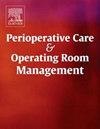一项比较横筋膜平面阻滞和腰方肌阻滞对剖宫产后疼痛管理的随机对照试验:疗效、执行时间和实用性
IF 1
Q2 Nursing
Perioperative Care and Operating Room Management
Pub Date : 2025-08-06
DOI:10.1016/j.pcorm.2025.100536
引用次数: 0
摘要
背景:腹横筋膜平面阻滞(TFPB)和腰方肌阻滞(QLB)在剖宫产后疼痛治疗中比腹横平面阻滞(TAPB)提供更好的镇痛效果。本研究评估了TFPB和QLB在镇痛效果几乎相同的情况下是否更可取,主要关注于执行的容易程度和执行时间。方法本随机对照试验将108例脊髓麻醉下择期剖宫产患者随机分为三组,分别接受TAPB(对照组)、TFPB和QLB。术后疼痛采用数字疼痛评定量表(NRS)在6、12和24小时作为主要结果进行评估。次要结果包括到第一次使用镇痛药的时间、前24小时内阿片类药物的总消耗量、阻滞执行的难易程度(分为容易、中等困难或困难)以及阻滞执行所需的时间。所有阻滞均由一名经验丰富的麻醉师在超声指导下进行,以确保一致性。结果与TAPB组相比,TFPB组和QLB组在术后6、12和24小时的疼痛评分均显著降低(p <;所有时间点0.001),TFPB和QLB之间的镇痛效果无显著差异(p >;0.05)。此外,与TAPB组相比,TFPB组和QLB组患者在24小时内需要的阿片类药物明显减少,并且在要求镇痛前需要的时间更长(p <;0.001)。值得注意的是,TFPB技术所需的执行时间明显少于QLB技术,并且被评为比QLB技术更容易执行(p <;0.001)。在研究期间,任何组均未观察到明显的并发症或不良事件。结论与TAPB相比,TFPB和QLB均具有更好的术后镇痛效果,两种技术的疼痛缓解效果相当。然而,TFPB与更短的执行时间和更容易的性能相关,使其在繁忙的临床环境中特别有利。这些发现表明TFPB可能是剖宫产后镇痛的首选方法,特别是在效率和简单性最重要的大容量产科单位。本文章由计算机程序翻译,如有差异,请以英文原文为准。
A randomized controlled trial comparing transversalis fascia plane block and quadratus lumborum block for post-cesarean pain management: Efficacy, execution time, and practicality
Background
Transversalis Fascia Plane Block (TFPB) and Quadratus Lumborum Block (QLB) provide superior analgesia to Transversus Abdominis Plane Block (TAPB) for post-cesarean pain management. This study evaluates whether TFPB or QLB is preferable when their analgesic efficacy is nearly equal, focusing on ease of performance and execution time.
Methods
In this randomized controlled trial, 108 patients scheduled for elective cesarean delivery under spinal anesthesia were randomized into three equal groups to receive either TAPB (control), TFPB, or QLB. Postoperative pain was assessed using the Numeric Pain Rating Scale (NRS) at 6, 12, and 24 hours as the primary outcome. Secondary outcomes included the time to first analgesic request, total opioid consumption within the first 24 hours, the ease of block performance (rated as easy, moderately difficult, or difficult), and the time required for block execution. All blocks were performed bilaterally under ultrasound guidance by a single experienced anesthesiologist to ensure consistency.
Results
Both the TFPB and QLB groups demonstrated significantly lower postoperative pain scores compared to the TAPB group at 6, 12, and 24 hours (p < 0.001 for all time points), with no significant difference in analgesic efficacy between TFPB and QLB (p > 0.05). In addition, patients in the TFPB and QLB groups required significantly less opioids within 24 hours and had a longer time before requesting analgesia than those in the TAPB group (p < 0.001). Notably, the TFPB technique required significantly less time for execution and was rated as easier to perform than the QLB technique (p < 0.001). No significant complications or adverse events were observed in any group during the study period.
Conclusions
Both TFPB and QLB offer superior postoperative analgesia compared to TAPB, with comparable pain relief between the two techniques. However, TFPB is associated with a shorter execution time and greater ease of performance, making it particularly advantageous in busy clinical settings. These findings suggest that TFPB may be the preferred method for post-cesarean analgesia, especially in high-volume obstetric units where efficiency and simplicity are paramount.
求助全文
通过发布文献求助,成功后即可免费获取论文全文。
去求助
来源期刊

Perioperative Care and Operating Room Management
Nursing-Medical and Surgical Nursing
CiteScore
1.30
自引率
0.00%
发文量
52
审稿时长
56 days
期刊介绍:
The objective of this new online journal is to serve as a multidisciplinary, peer-reviewed source of information related to the administrative, economic, operational, safety, and quality aspects of the ambulatory and in-patient operating room and interventional procedural processes. The journal will provide high-quality information and research findings on operational and system-based approaches to ensure safe, coordinated, and high-value periprocedural care. With the current focus on value in health care it is essential that there is a venue for researchers to publish articles on quality improvement process initiatives, process flow modeling, information management, efficient design, cost improvement, use of novel technologies, and management.
 求助内容:
求助内容: 应助结果提醒方式:
应助结果提醒方式:


